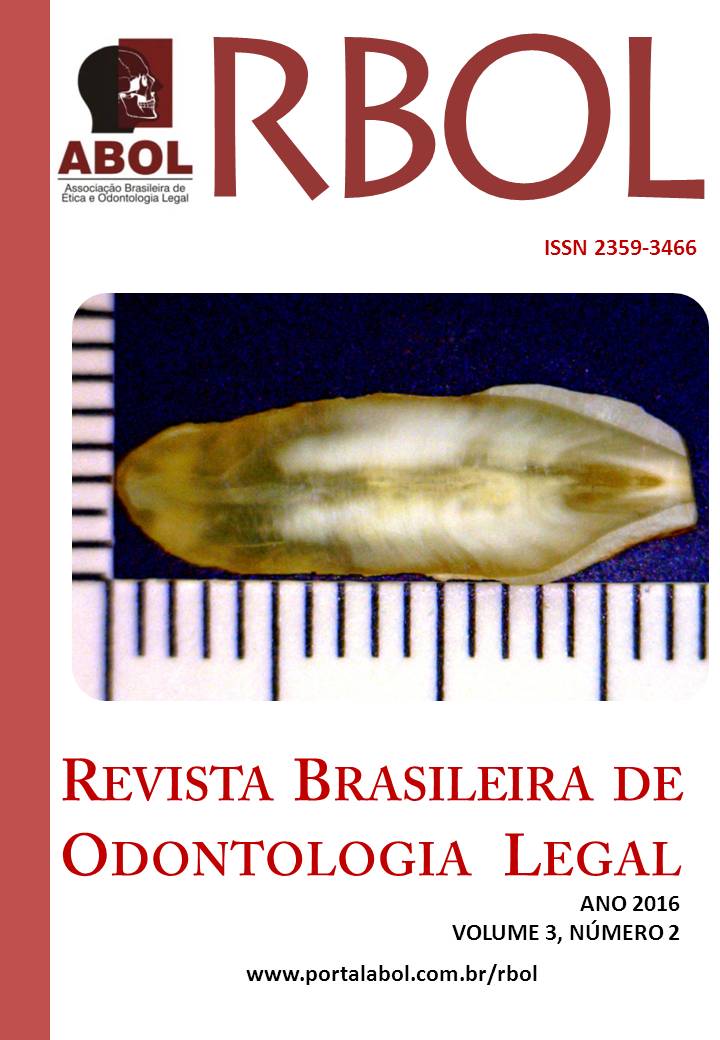VALIDATION OF 3D METRIC AND SUPERIMPOSITION TOOLS IN THREE SOFTWARE PACKAGES FOR THE MORPHOLOGICAL COMPARISON OF LASER SCANNED ANTERIOR DENTITION MODELS
DOI:
https://doi.org/10.21117/rbol.v3i2.2Palavras-chave:
Forensic sciences, forensic dentistry, dentition, morphology, 3D imaging, softwareResumo
Introduction: Few studies succeeded on demonstrating that dentitions are unique. Methodological limitations may have influenced these outcomes. Objective: The present study aims to validate software packages for comparing human dentitions. Material and methods: A pool of 40 dental casts were laser scanned (XCAD 3D®, XCADCAM Technology®, São Paulo, Brazil) and implemented in Geomagic Studio® (GS) (3D Systems®, Rock Hill, USA), Cloud Compare® (CC) (Telecom Paris Tech® and EDF®, Paris, France), and Maestro 3D Ortho Studio® (MS) (AGE Solutions®, Pontedera, Italy) software packages to evaluate metric and superimposition tools. Results: Software performances did not significantly differ (p>0.05) considering cropping, landmarking and superimposition functions. GS was more precise for detecting identical models (p<0.05). Inter and intra examiner reproducibility reached optimal outcomes. Calibration was assured for software measuring tools and scanning process. Conclusion: Both GS and CC may be used for comparing 3D anterior dentitions. However, more practical and less operator-depending procedures are available in GS.Referências
USA. National Research Council. Committee on identifying the needs of the forensic sciences community. Strengthening forensic science in the united states: a path forward. 2009.
The innocence project. Available from: http://www.innocenceproject.org.
Senn DR, Weems M. Manual of forensic odontology. 5 Ed. CRC Press; 2013.
Franco A, Thevissen P, Coudyzer W, Develter W, Van De Voorde W, Oyen R, et al. Feasibility and validation of virtual autopsy for dental identification using the Interpol dental codes. J Forensic Leg Med. 2013; 20(4): 248–54. http://dx.doi.org/10.1016/j.jflm.2012.09.021.
INTERPOL. Disaster victim identification guide; 2014:127.
Pereira CP, Santos JC. How to do identify single cases according to the quality assurance from IOFOS. the positive identification of an unidentified body by dental parameters: a case of homicide. J Forensic Leg Med. 2013; 20(3): 169–73. http://dx.doi.org/10.1016/j.jflm.2012.06.004.
Dorion R. Bite mark evidence: a color atlas and text. 2 Ed. CRC Press; 2011.
Franco A., Willems G., Souza PHC., Bekkering GE., Thevissen P. The uniqueness of the human dentition as forensic evidence: a systematic review on the technological methodology. Int J Legal Med 2015;129(6):1277–83. http://dx.doi.org/10.1007/s00414-014-1109-7.
Kieser JA, Bernal V, Neil Waddell J, Raju S. The uniqueness of the human anterior dentition: a geometric morphometric analysis. J Forensic Sci. 2007; 52(3): 671–7. http://dx.doi.org/10.1111/j.1556-4029.2007.00403.x.
Bush MA, Bush PJ, Sheets HD. Similarity and match rates of the human dentition in three dimensions: Relevance to bitemark analysis. Int J Legal Med. 2011; 125(6): 779–84. http://dx.doi.org/10.1007/s00414-010-0507-8.
Sheets HD, Bush PJ, Brzozowski C, Nawrocki LA, Ho P, Bush MA. Dental shape match rates in selected and orthodontically treated populations in New York State: A two-dimensional study. J Forensic Sci. 2011; 56(3): 621–6. http://dx.doi.org/10.1111/j.1556-4029.2011.01731.x.
Sheets HD, Bush PJ, Bush MA. Patterns of variation and match rates of the anterior biting dentition: characteristics of a database of 3d-scanned dentitions. J Forensic Sci. 2013; 58(1): 60–8. http://dx.doi.org/10.1111/j.1556-4029.2012.02293.x.
Blackwell SA, Taylor RV, Gordon I, Ogleby CL, Tanijiri T, Yoshino M, et al. 3-D imaging and quantitative comparison of human dentitions and simulated bite marks. Int J Legal Med. 2007; 121(1): 9–17. http://dx.doi.org/10.1007/s00414-005-0058-6.
Martin-de-las-Heras S, Tafur D. Comparison of simulated human dermal bitemarks possessing three-dimensional attributes to suspected biters using a proprietary three-dimensional comparison. Forensic Sci Int. 2009; 190(1-3): 33–7. http://dx.doi.org/10.1016/j.forsciint.2009.05.007.
Martin-de-Las-Heras S, Tafur D, Bravo M. A quantitative method for comparing human dentition with tooth marks using three-dimensional technology and geometric morphometric analysis. Acta Odontol Scand. 2014; 72(5): 331–6. http://dx.doi.org/10.3109/00016357.2013.826383.
Bush M A, Bush PJ, Sheets HD. Statistical Evidence for the Similarity of the Human Dentition. J Forensic Sci. 2011; 56(1): 118–23. http://dx.doi.org/10.1111/j.1556-4029.2010.01531.x.
Sognnaes RF, Rawson RD, Gratt BM, Nguyen NB. Computer comparison of bitemark patterns in identical twins. J Am Dent Assoc. 1982; 105(3): 449–51.
Habib F, Fleischmann L, Gama S, Araújo T. Obtenção de modelos ortodônticos. Rev Dent Press Ortod E Ortop Facial. 2007; 12: 146–56.
Dofka CM. Competency skills for the dental assistant. 1 Ed. Delmar Publishers; 1995.
Franco A. Unique or not unique?! That is the question! - Opinion article on a bitemark scope. RBOL 2015;2(2):126–31. http://dx.doi.org/10.21117/rbol.v2i2.36.
Naether S, Buck U, Campana L, Breitbeck R, Thali M. The examination and identification of bite marks in foods using 3D scanning and 3D comparison methods. Int J Legal Med. 2012; 126(1): 89–95. http://dx.doi.org/10.1007/s00414-011-0580-7.
Thali MJ, Braun M, Markwalder TH, Brueschweiler W, Zollinger U, Malik NJ, et al. Bite mark documentation and analysis: the forensic 3D/CAD supported photogrammetry approach. Forensic Sci Int. 2003; 135(2): 115–21. http://dx.doi.org/10.1016/S0379-0738(03)00205-6.
Downloads
Publicado
Edição
Seção
Licença
Os autores deverão encaminhar por email, devidamente assinada pelos autores ou pelo autor responsável pelo trabalho, a declaração de responsabilidade e transferência de direitos autorais para a RBOL, conforme modelo abaixo.
DECLARAÇÃO DE RESPONSABILIDADE E TRANSFERÊNCIA DE DIREITOS AUTORAIS
Eu (Nós), listar os nomes completos dos autores, transfiro(rimos) todos os direitos autorais do artigo intitulado: colocar o título à Revista Brasileira de Odontologia Legal - RBOL.
Declaro(amos) que o trabalho mencionado é original, não é resultante de plágio, que não foi publicado e não está sendo considerado para publicação em outra revista, quer seja no formato impresso ou no eletrônico.
Declaro(amos) que o presente trabalho não apresenta conflitos de interesse pessoais, empresariais ou governamentais que poderiam comprometer a obtenção e divulgação dos resultados bem como a discussão e conclusão do estudo.
Declaro(amos) que o presente trabalho foi totalmente custeado por seus autores. Em caso de financiamento, identificar qual a empresa, governo ou agência financiadora.
Local, data, mês e ano.
Nome e assinatura do autor responsável (ou de todos os autores).

